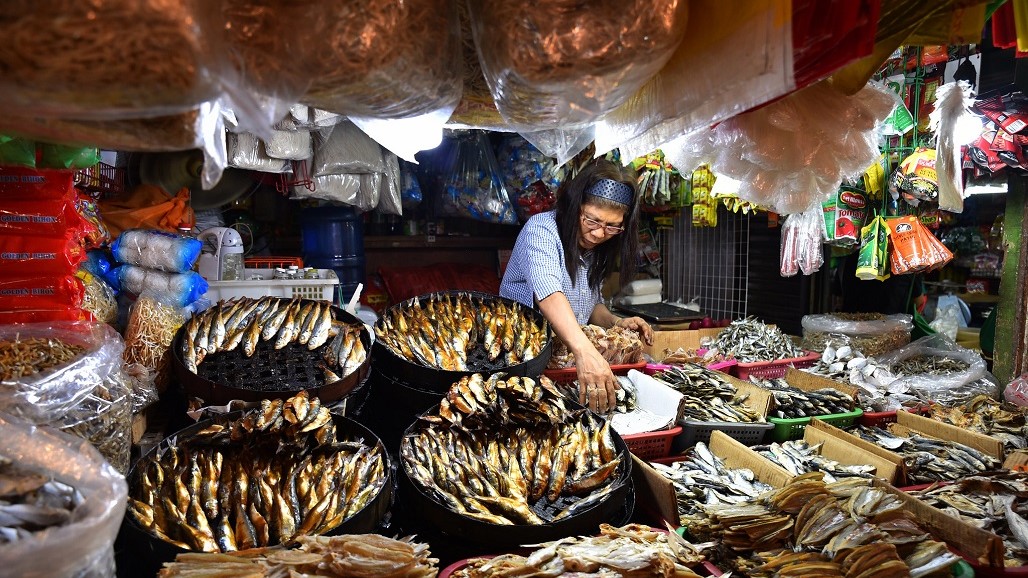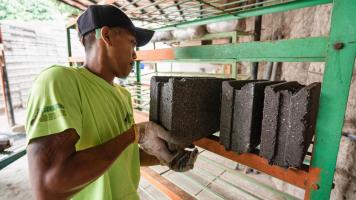
On average, MSMEs account for 97% of all enterprises and 69% of the total workforce in Southeast Asia. Photo credit: ADB.
Prioritizing the most vulnerable and a tailored approach are just among the measures needed to steer MSMEs through the COVID-19 crisis.
Micro, small- and medium-sized enterprises (MSMEs) may be the backbone of Asia’s economy, but in reality, they are “fragile entities.”
Shigehiro Shinozaki, a senior economist at the Asian Development Bank (ADB), says MSMEs are fragile because they are easily disrupted by external shocks, such as financial crises, disasters, and sudden changes in the business environment, like with what happened with the coronavirus disease (COVID-19) pandemic.
“Governments need to understand the real conditions of MSMEs to set the right policy measures,” says Shinozaki, one of the authors of a study that looks at MSMEs in Southeast Asia and analyzes the challenges facing them.
At a webinar on COVID-19 Recovery Support to BIMP-EAGA SMEs, Shinozaki cites a rapid survey conducted by ADB in March and May in Southeast Asia when most governments around the world implemented lockdowns. The survey showed the immediate shutdown of majority of the MSMEs in the Lao People's Democratic Republic (Lao PDR) and the Philippines and less than half in Indonesia and Thailand.
Domestic demand dropped for 40% of MSMEs polled in the Lao PDR and Thailand and 30% of businesses in Indonesia and the Philippines. The survey also found supply disruptions in more than 30% of MSMEs in the Philippines and Thailand and less than 20% in the Lao PDR and Indonesia.
Finding the right policy measures
According to the ADB study, Southeast Asia’s robust growth over the past 10 years has been underpinned by MSMEs. As such, strengthening their role through structural reform will be critical in maintaining the region’s dynamism.
MSMEs account for 97% of all enterprises, 69% of the total workforce, and 41% of a country’s gross domestic product between 2010 and 2019, the report says. “In many ways, MSMEs hold the key to economic recovery in developing Asia.”
Given the importance of MSMEs in Southeast Asian economies, here are seven policy thrusts governments and stakeholders should look at to strengthen MSMEs in the region.
1. Help the most vulnerable.
Shinozaki says 90% of the MSMEs polled wished they had access to zero-interest and collateral-free loans.
Subsidies, cash transfers, and grants, meanwhile, ranked second among MSMEs in Indonesia, the Philippines, and Thailand, while those in Lao PDR pressed for a refinancing facility.
Shinozaki says the survey showed that MSMEs in all four countries faced a serious lack of funds to retain their business, especially those in Indonesia. Financial support was thus top of mind, particularly for the most vulnerable MSMEs, he says, such as those in manufacturing, traditional trade, tourism and hospitality, and transport. These also include women-led MSMEs and enterprises with global operations as they sustained more serious damage.
He says focusing assistance to the most vulnerable MSMEs would encourage governments to use limited budget and support more effectively.
2. Apply a phased approach.
Shinozaki says a phased approach in providing support to MSMEs would allow for more flexibility in designing support measures, depending on the sector and the situation. This would also allow MSMEs to adjust to the business environment as COVID-19 continues to disrupt their operations.
3. Tailor policy measures based on business size.
Designing policy measures according to the size of the businesses will also be more helpful to MSMEs, says Shinozaki, noting each business copes differently with disruptions depending on their resources.
Citing the survey, he notes that micro and small businesses immediately laid off staff during the pandemic, while medium-sized businesses, which have more resources, were able to retain them. Some even had the means to allow their people to work from home during the lockdown.
4. Help businesses shift to the digital economy and adopt work-from-home arrangements.
Shinozaki says the survey showed most MSMEs did not use e-commerce or digital finance during the pandemic. Given COVID-19, there is a need for MSMEs to shift to digital, or contact-less transactions, which is safer for both staff and customers. To this end, MSME owners and employees need digital skills training, he adds.
Speaking at the same webinar, Javed Ahmad, CEO of Darussalam Enterprise (DARe), says Brunei Darussalam is working with Google to train 4,000 micro enterprise owners on technology and running a business. During the crisis, he said DARe saw interest in people wanting to improve their business skills, prompting the country’s national SME body to organize virtual training and mentoring instead of face-to-face trainings.
John Carlo Tria, president of the Davao City Chamber of Commerce and Industry, also stresses the need for digital transformation among MSMEs, particularly agricultural producers, noting in the Philippines the government has introduced mentoring programs for MSMEs to help them go online. “We all know that the pandemic is going to be here for the long term. It’s no longer a case wherein we can wait for it to suddenly disappear. It will take time and the building of business confidence will also be a process,” he says, noting the need for digital platforms, including fintech. “This kind of digital economy intervention is what will really build resilience.”
As shown by the survey, Shinozaki adds small businesses do not have the means to allow staff to work from home. In all the countries surveyed, work-from-home arrangements were not popular among MSMEs. Yet he says there is a need to promote such arrangements to allow MSMEs to continue operating amid the pandemic.
5. Disseminate information about government support programs, especially financial support.
Governments and stakeholders also need to strengthen the dissemination of information about government support programs, says Shinozaki. This will ensure those programs will reach
target beneficiaries given that most MSMEs still rely on informal financing.
At the height of the crisis, MSMEs in the countries surveyed mostly relied on their own funds and borrowing from informal sources, or family, relatives, and friends to sustain operations.
6. Focus on business and employment retention measures.
COVID-19 has worsened unemployment in many countries. As such, there is a need for measures to help MSMEs retain their employees while making sure they remain in business, says Shinozaki.
Another webinar panelist, Dr. Rafiq Idris, director of Universiti Malaysia Sabah, says one of the priority measures governments in BIMP-EAGA need to address is the decline in demand for products and services of MSMEs. He says governments can do this by extending financial assistance to consumers to increase their purchasing power. “Member countries should intervene to create and sustain demand for products, only then can SMEs be safe.”
Reskha Handayani, chief biological officer of U&Ge-Pioneer Sustainable Aquaculture of Indonesia, meanwhile, presses BIMP-EAGA countries to accelerate subregional cooperation to widen trade access as a way to help MSMEs stay in business.
7. Monitor the condition of MSMEs.
Since COVID-19 continues to disrupt businesses, there is a need to continue monitoring MSMEs so governments can fine-tune their policy support to the sector, says Shinozaki.
Rafiq says BIMP-EAGA countries need to have regular dialogues concerning MSMEs and trade. This may involve setting up a centralized or dedicated web page that updates all countries on such concerns during the pandemic. “We need to coordinate efforts to increase our collective recession-fighting power.”
This article was first published by BIMP-EAGA on 19 November 2020.

BIMP-EAGA
The Brunei Darussalam–Indonesia–Malaysia–Philippines East ASEAN Growth Area, or BIMP-EAGA, is a cooperation initiative established in 1994 to spur development in remote and less developed areas in the four participating Southeast Asian countries.


